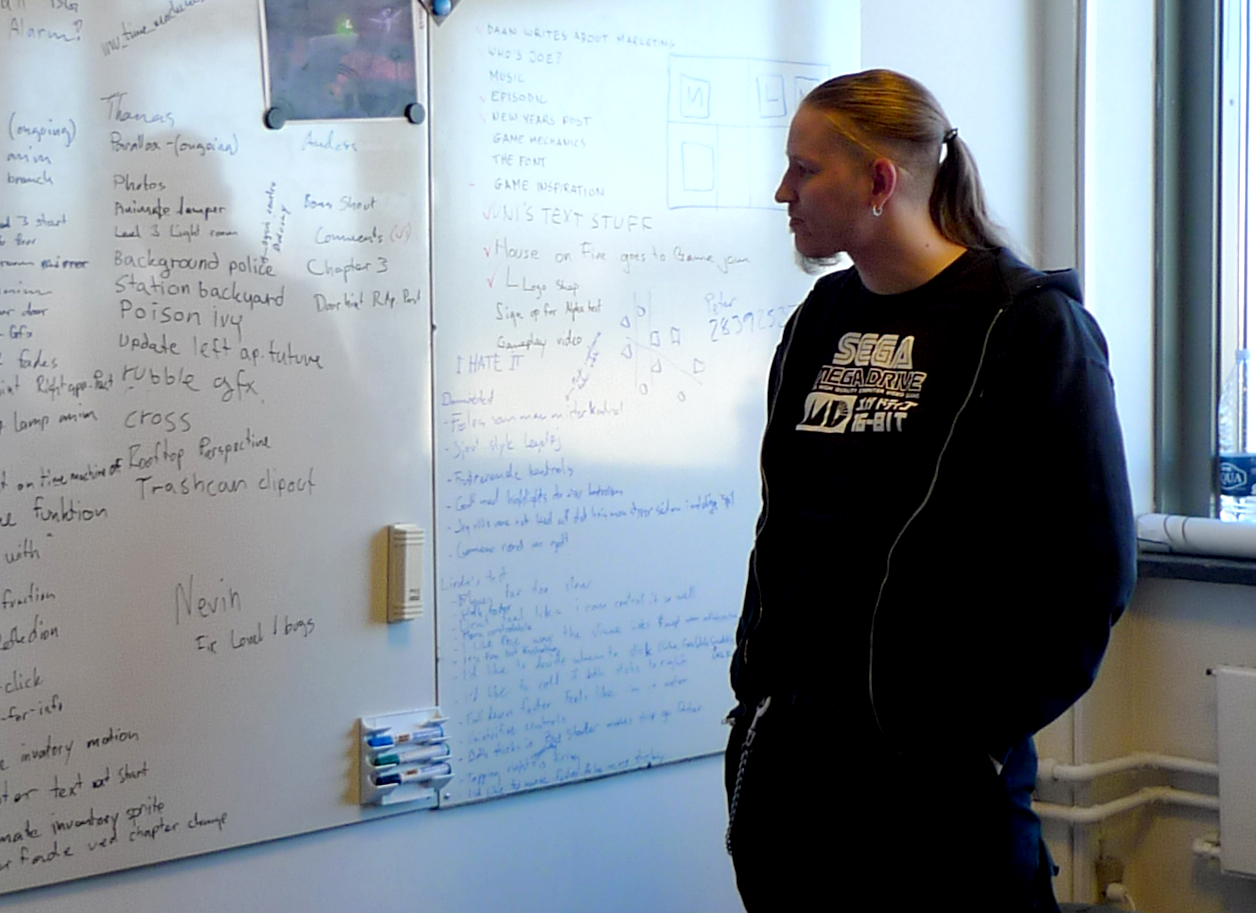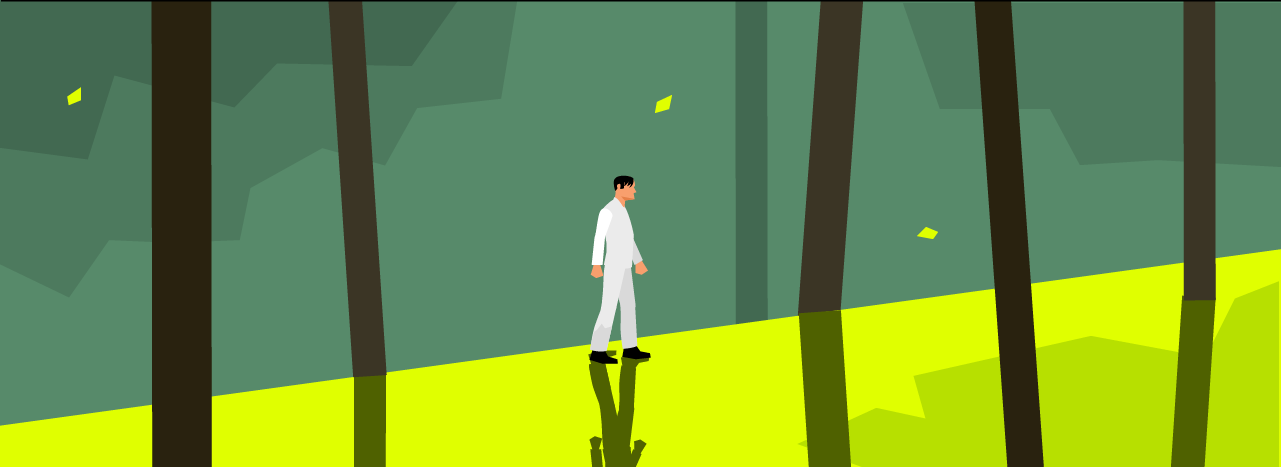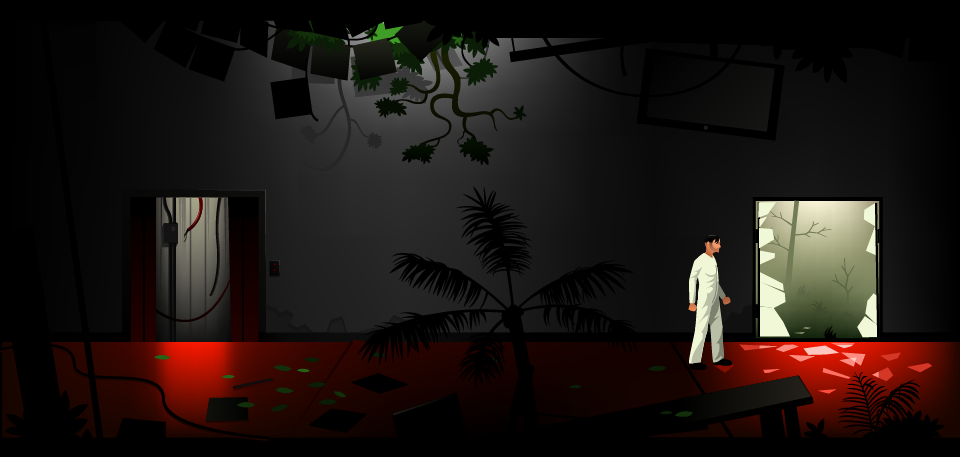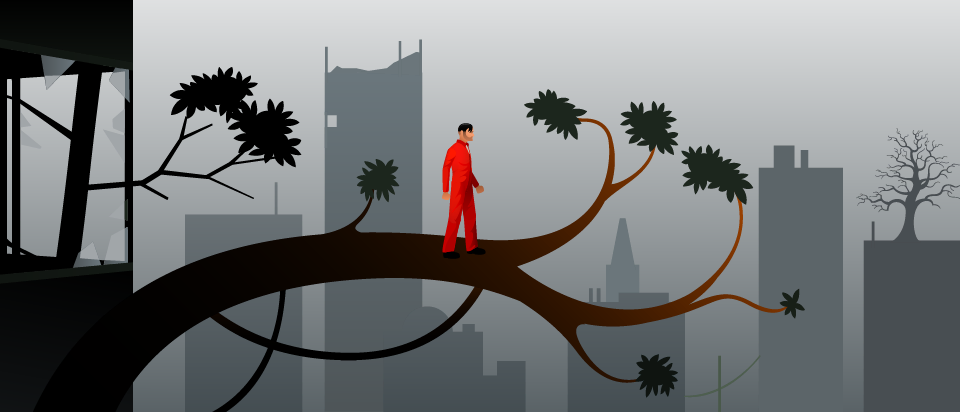Meet Anders. He’s the author and screen writer on The Silent Age. We’ve fabricated this little interview ourselves, in which we’ve asked him a number of relevant questions about stuff like screen writing, character development and storytelling.
Q: Please tell us about yourself.
Hi everyone. My name is Anders and I’ve just managed to stump myself at the very first question. Well done, me. I’ve been staring at this question for thirty minutes now and I really have no clue how to describe myself beyond my physical attributes. If I had to start somewhere, I guess I’d say that I’m bit of a geek in many different fields; music, video games, comics, photography, A/V, computer history, etc. I never entertain fleeting, superficial interests either – I get intensely passionate about anything that piques me. I do graphics, urbex photography, tinker with A/V hardware, build arcade machines, write columns and reviews and a billion other things.
I’ve played video games since my dad hauled home our very first game console – the Magnavox Odyssey 7000. I started programming (on the Commodore 64) around age nine and quickly got fed up with the tedium of typing in colour values and coordinates for every pixel in every sprite (as was par for the course back then) and instead found joy in creating text adventures. When tools got better, I started doing graphics, which quickly turned into my livelyhood and later my interests in UI and ergonomics drew me in a more usability-related direction. As a secondary income I used to work at a venue and write a column for an early online music publication and I’ve attended many hundreds of concerts. Not incidentally, everything in my life is set to music, and I enjoy anything from jazz to black metal.
Q: What is your role in House on Fire?
I write the story, the narrative and the dialogue and generally function as a creative wall for Thomas to bounce ideas off of.
I also give my input in UX matters whenever it’s needed, since that happens to be my day job.
Q: How did you get involved in the development of The Silent Age?
I’m an interaction designer by trade and I used to work at a big company doing interactive televison. This is where I met Thomas in 2006, and from the moment I met him I knew there was something there. That something grew into a special friendship. Thomas was working in the games department of the company at the time, and me having done small-scale, spare-time forays into game development in the past, I grew more and more interested in pursuing that. Eventually I asked to be transferred to the games group, where I ended up working along side him and Linda on various projects for a year and a half. When the department closed down at the end of 2010, it sprouted a handful of game development upstarts – among them House On Fire, which Thomas founded together with Uni and Linda.
While I was looking for other work and trying to find things to occupy me, Thomas regularly called me in for little sessions where he’d bounce game ideas off me and ask for input both on the creative and UX side of things. The Silent Age was starting to take shape at that point, and he was already sketching out and experimenting with the art style and setting. As he was aiming for a very minimalistic, art-focused, visual approach, he originally intended for the game to be without words. However, it quickly became apparent to both of us that the story he was playing around with was too complex to be told silently. Also, I felt that without lots of animation to allow the protagonist to express himself, it would be hard for the players to identify with him. The tone of the game was also sombre enough to make a Buster Keaton approach entirely detrimental to the experience.
As we kept discussing and developing the story, our protagonist Joe developed alongside with it and I kept coming up with scenarios and suggestions to how Joe would act and respond to things. Thomas knew about my passion for writing, and he eventually asked me if I wanted to give Joe his proverbial voice. I happily accepted the challenge and ended up doing all the dialogue, comments and narrative. For episode two I’ve taken over full responsibility for the story as well.
Q: Which fictional genres do you prefer and which fictional works do you consider your favorites?
I enjoy science fiction, horror, magical realism and noir a lot. Science fiction I love not only because it allows me to experience alternate worlds or follow a tangent to our potential future, but also very much because it deals with grand ideas, expands horizons and allows us to shed our preconceptions to let us view contemporary problems in a new light. Science fiction has shaped my views in so many ways, I feel it should be every politician’s duty to sit through a number of master works in the genre before they’re allowed to set foot in office.
In regards to my love of magical realism, I know it has sadly become shorthand for the young adult paranormal romance subgenre these days, but magical realism encompasses so much more than this. The beauty of the genre is that it inspires me to imagine exciting things in the mundane; that my surroundings is merely a curtain obscuring a secret world that’s just slightly out of view. Horror, at least for me, is very much an extrapolation of this – it’s just a hidden world that’s vastly more unpleasant. My love for horror also has a sort of therapeutic side to it, since all of my life I’ve been afraid of pretty much everything. Not incidentally, that’s also why I hold Lovecraft in such high regard, as unreadable as many find his works. – There’s a kinship there.
In regards to noir, I realise it isn’t an actual genre, so much as a mood and style that can be dispensed over everything from detective novels to science fiction, but I seem to gravitate toward it nonetheless. I love heavy, dark, moody atmospheres with a bit of melancholy thrown in.
In the interest of not making this an overly long answer, I’ll reduce my list of influences to just the ones off the top of my head: Charles Stross, John Scalzi, Neil Gaiman, H.P. Lovecraft, Clive Barker, Alan Moore, Ken Levine, Jim Woodring, Darren Aronofsky, Ridley Scott, Hitchcock, Kubrick, Lynch, Cronenberg. In terms actual works I hold dear, in no particular order or medium, I would have to mention Accelerando, Old Man’s War, Watchmen (the graphic novel), the Silent Hill games, Solaris, 2001: A Space Odyssey, Soylent Green, Forbidden Planet, Altered States, Alien, Bladerunner, The Thing, Contact, Pi, Beyond The Black Rainbow, Wings Of Honneamise, Katsuhiro Otomo’s “Memories”, Cowboy Bebop, Neon Genesis Evangelion, Star Trek: TOS and Babylon 5.
Q: Can you describe Joe’s personality?
The beauty of Joe is that his entire personality is really summed up in his name. He’s a regular, working Joe. There is only so much depth you can add to a character with little human interaction in a moderately short game, so from the outset, both Thomas and I wanted to make him the archetypical everyman. Someone most people would be able to relate to. In order to tap into the tone of the game, I wanted to make Joe a kind of tragic character, but with the important distinction that he isn’t really all that aware of it. From the opening of the game we show a montage of a man whose life has clearly dealt him nothing but lemons, but despite this, Joe doesn’t revel in self-pity. He just goes with the flow and let the chips fall where they may. He doesn’t push back or hold a grudge. I think it’s important to point out that I don’t perceive Joe as dumb. He’s just uneducated and not very worldly. Most of what he knows is either anecdotal or stuff he learned from TV. He knows enough to get by.
In order to solicit the player’s sympathy for him rather than viewing him as a bumbling ignoramus, it was important for me to show Joe as a person who always tries his best. At the end of the day, I want him to be a guy you’d want to hug, rather than scold for his failures.
Q: What inspired you when developing Joe’s personality?
Joe is mainly bits and pieces of friends and family, and I know Thomas is going to have me lynched when I say this, but actually quite a bit of Joe comes from observing Thomas. At that big company where we both used to work, there would be regular team meetings where you’d have architects, designers, programmers and artists in one room trying to flesh out a product. As meetings like these tend to go, they’d often spark intense debates over intricate implementation details when all of a sudden someone in the back of the room would go “Whoah, whoah, whoah! I don’t get it.” and then follow up with an almost childlike question that seemed so dumb and elementary, you’d think the person was either retarded or hadn’t been paying attention at all the whole time. For a few scant seconds there’d be a lot of groaning and rolling of eyes, but then brows would furrow and everyone would start realizing that we were actually going about it all wrong. It was like having a group of engineers stranded on an island, quibbling over how to build the aeronautical guidence system for a vertical takeoff jetplane in order to reach the coconuts at the top of a palm tree, and then have a guy ask why we couldn’t just shake the tree. That guy was Thomas, and if there’s one thing I’ve striven to bring to Joe as a character, it’s that childlike brilliance.
Q: There’s a lot of humor in Joe’s inner monologue, which contrasts the dark and moody world of The Silent Age. Was that a deliberate design choice or is it simply because you have a personal taste for comedy?
I do think my personal tastes has something to say, but I also strongly feel that juxtaposition of contrasts has to be there in order for the player to truly appreciate the setting and tone without it growing stale. I.e. you can only truly appreciate horror if you’ve been exposed to calmness. In the same vein, humour is only truly funny when contrasted against harsh realities. In anything you spend a prolonged stretch of time doing, you have to break things up in order the fend off fatigue. You have to include curves along that line.
Writing smart, witty characters comes easy for me, but Joe is none of those things. My favourite archetype to write is the world-weary sleuth with the snarky remarks and almost poetic inner monologue. It’s the guy who’s always one step ahead of the curve. Dr. Montgomery House would be a perfect example of such a character. For Joe, I had to entirely subdue my own wit, forego that unnatural omnipotence and moderate my vocabularium quite a bit. At the same time I wanted his comments to be occasionally funny without having him crack jokes, since that would feel entirely out of place for both the character and circumstances. The humour in the game had to be a play on Joe’s limited understanding of his situation versus the player’s. The initial 1972 setting was a great help there, since I have the player’s hindsight and knowledge of the time period to play off of. Joe’s inability to read between the lines, his propensity to misintepret his surroundings and to focus on insubstantial details while missing the big picture were all great vessels for humour too.
Q: Do you follow certain dogmatic rules when writing Joe’s comments?
I don’t consciously set rules for myself, but I have a definite sense of right and wrong in relation to a character and the world it inhabits. Characters quickly gain their own life in my head and reach that important point where I know that character so well that I can start throwing situations at it and immediately know what their reaction is going to be. Of course, it’s usually an array of possible outcomes, since even people you’ve known your whole life can still manage to surprise you. However, there’s always a strong sense of the plausibility of each of the possible reactions.
One thing I do believe strongly in when writing stories or characters is the necessity of the unnecessary. What I mean by that is that for worlds and characters to truly come alive, there has to be quirks and details with no real purpose. I’m not talking about red herrings here, but texture. Stories where every character, description and detail serves a purpose and everything is tied up with a neat little bow at the end feel claustrophobic and unbelievable to me. Like being on an old western movie set where every gust of wind make the flat, plywood building façades sway. Odd little details, a speech impediment or an anecdote that has nothing to do with the core story other than for the player to latch on to it and wonder – all these things go such a long way in terms of making an experience memorable.
Those sorts of realizations can come from anywhere, and I distinctly remember the first time I paid notice to this. Joss Whedon is really a masterful quirksman and in the final episode of Firefly, he introduces us to a ruthless bounty hunter called Jubal Early. Some miss this, but when crewmember Simon is cornered and asks Jubal: “are you Alliance?”, Jubal replies: “Am I a lion? I don’t think of myself as a lion.” His mishearing things happens a couple of times during the episode, but is never delved upon. It’s never explained whether he’s hard of hearing or is just easily distracted, and while there was never any reason for the quirk to be there in the first place, the effect it had on humanizing him and making him a believable character was simply brilliant.
Q: Can you describe Joe’s character development through The Silent Age?
Joe does tend to lean on the seven stages often attributed to grief. He goes from care free to shock during the first level, denial and acceptance in level two and three. He skips a few and I don’t follow the stages religously, but it’s been important for me to establish Joe as regular person, and not an action hero. That doesn’t change much throughout the game. He’s a fearful and largely careful person, and a few days of of crazy experiences won’t suddenly change his personality. Of course I couldn’t have him cower in fear and curl up in a corner at the first sign of adversity either, or the player would get absolutely nowhere, but at the same time I wanted him to have something closer resembling the reactions you’d have when confronted by horrors in a dazed and confused state.
Once Joe starts accepting his role, he does start taking charge of it in his own bumbling way, and while I will not spoil anything in episode two, Joe’s assumptions and mental state will certainly be put to the test.
Q: What’s your favorite one-liner in The Silent Age?
I try not to include actual zingers in anything Joe says, since he’s not a natural joker. The comedy is very much meant to be involuntary. I do enjoy writing some of his more self-deprecating, anxiety-laden comments, though, like the ones in the police station interrogation room. Looking at the one-way mirror, Joe comments “I see a pale, scared guy in there. It’s me.” Tapping the security camera in the corner, he’ll mutter: “I hope the ten pounds you gain on TV stays permanent. Scrawny guys like me don’t last long in prison.”
Q: Can you describe the writing process?
“Modular and iterative” would be short answer. I never write in a straight line. As I write, related ideas pop up all the time, and I jot them down every time they do. Mentally I create invisible strings between all the disjointed pieces and at the last minute I pull the master string and they all assemble. If you were to look over my shoulder, the process would look entirely chaotic, but there’s a system to it. I can’t really quantify it, but it’s there.
For more structured stories, the system is much more tangible. Here I will immediately start typing in a bunch of words or short sentences for all the things I’d like to happen or exist. Then I rearrange them into a hierachy or disposition and start fleshing them out, one by one. I do this in several passes. The first pass is usually incredibly bad and not worthy of anyone’s time. The important bit, however, is not to stop. If I get stuck on one thing, I immediately move to another to keep a constant flow of words. This method has proven extremely effective for me in overcoming fear of the blank page or writer’s block. Once I have a lot of text committed to pages, even if it’s incoherent crap, it becomes much easier for me to put on my editor’s glasses and view it like it was someone else’s work and start improving on it. This is the part of the process I enjoy most, actually. – The tinkering and fine tuning.
The actual writing and editing only takes up about half my time, however. The other half is spent researching. With the game taking place in 1972, I took my time tapping into the the zeitgeist of that period, reading up on the political climate, the news stories and social issues. I also had a lot of fun watching movies, documentaries and news clips to make sure the vernacular didn’t stick out like a sore thumb. While some players may brush over these things and just play the game like a fun little puzzle-filled romp, it’s incredibly important to me that these things are accurate for the players who appreciate the setting and story. Not least because Thomas went out of his way to include period correct colouring, patterns and interior decor.
Q: What inspired you when writing the story?
Thomas and I are very much into 70’s filmmaking as it was simply a terrific decade for the medium. Throughout the sixties, the studio system had been stuck in a rut. Financially it was doing poorly and even though Hollywood had found a new disposable income audience in the teenage demographic, the studios weren’t as succesful in reeling them in with their strict production code that dictated all films should be good, clean and wholesome. At the same time, the availability of equipment and cost of film production had come down to a level where anti-establishment independent filmmakers were starting to undermine the studios. The studio code was lifted just in time for Easy Rider to arrive as a real wake-up call for Hollywood, and for the next decade, the panicked studios became much more risk averse and gave almost entirely free creative reign to young, visionary film makers.
It’s no coincidence that this climate produced some of the best sci-fi films in all of film history, and that time period’s openness to hallucinagens made for some pretty intense, ambience-soaked and paranoia-induced storytelling. By the time I got involved with The Silent Age, Thomas had already done the logo type, and based on this alone, I immediately knew what direction the game was headed. We both wanted to re-create that eerie, foreboding tone these movies had and I basically just piled on. From Beneath the Planet Of The Apes to The Andromeda Strain, Capricorn One and countless others we discussed, I tried to reinforce that sense of unease in my writing.
Q: Do you follow certain rules when writing the story?
As with Joe’s comments, I don’t really follow rules consciously. As with characterisation, world building does the same thing for me in terms of dictating where the story could go and what feels right or wrong.
Q: Can you describe the challenges you’re facing when writing a story for an interactive platform as opposed to a non-interactive platform?
Writing a story or framework for a linear game with closely paced progression is not that much different from writing for other linear media – even when time travel is involved. However, it does have a huge effect on writing once you start allowing players to roam, explore and switch time periods on their own.
Writing character progression within levels has actually been an interesting challenge, one of the reasons being that to keep complexity down we chose to make the system for Joe’s comments stateless. What this essentially means is that for large stretches of the game where the player is free to wander between multiple rooms or time zones, I can’t always make sure what the player has or hasn’t subjected Joe to yet, and thus have him refer back to those events in any meaningful way. This poses a problem since the core of character progression is having the character change its outlook on the situation based on past events or experiences. We did a number of things to work around this. Sometimes we’d include certain unavoidable events within levels to make sure I could safely refer back to them. Other times I’d have to be really clever with my writing and make Joe comment in a way that would feel perfectly valid irregardless of whether or not the player had subjected him to a specific action earlier.
The biggest challenge however, was the time travel. As anyone who’s read or watched lots of fiction involving time travel, the ripple effect of changing things in the past should be readily apparent. However, while we chose to keep ramifications low on the time-related puzzles in Episode One, the continuation of the story in Episode Two involves us attempting to tackle some known conundrums which suddenly had me grow massive head aches trying to untangle the problems of writing in multi-dimensional and often recursive space. It’s been a lot of fun, though. And while I can’t spoil anything, I really hope fans will appreciate what we’ve done. 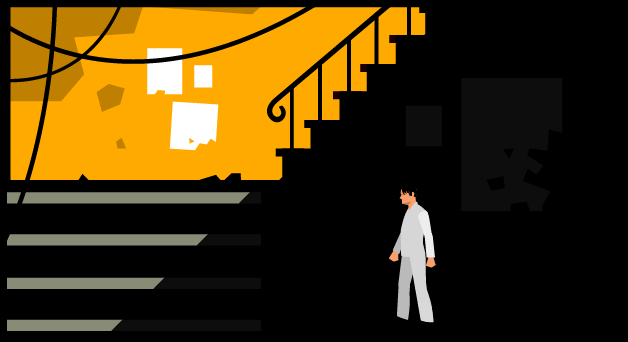
Q: When writing the story, are you following any dramatic models – like The Hero’s Journey, Red herring or Chekhov’s gun?
It’s nearly impossible not to fall into one or more of the classic models, but while I hate to sound like a broken record, again I’d have to say that I rarely do this on a conscious level as I write. I usually realize the models, tropes and idioms after I step back from the keyboard. When I’m doing my story sessions with Thomas I will, however, most certainly wave them around like a pointed stick at a vampire convention as I’m arguing for the in- or exclusion of certain elements. ![]()
Q: When writing the story, do you have a certain target audience in mind?
I’ve not really had to do that here, because the target audience is me. But even given different circumstances, I think most writers, painters, musicians, or anyone else with a creative output, create what they themselves would enjoy. At least I hope they do. For my money that really is the only way to remain passionate and produce your absolute best work. Of course this is a luxury squarely attributed to auteurs. Once you enter a team, that kind of autonomy goes away. However, while I still have to answer to the rest of the team, we’re so small and so in tune that I’m fortunate enough to be allowed that kind of freedom. But despite the fact that I’ve not had anyone else in mind during the creative process, even more fortunate is the fact that so many people have taken to the game. While most probably never realize how much their feedback means to me and the others, the comments I’ve read on reviews, on the App Store and Google Play have given me incredible boosts of confidence in times where I’ve felt my life was on pilot light.
Writing for yourself is of course one thing, but to say that the players haven’t had any influence on the direction of the story would be a blatant lie. After the release of Episode One we had such a barrage of input from players sharing their thoughts and expectations for the as-of-yet unrevealed parts of the story, that I realized that what we had planned for Episode Two was simply not good enough. After a chat with Thomas I therefore went back and started from scratch, and I can say with all honesty that the game is much better for it.
Q: What kind of experience do you want the player to have when playing the game?
There is a small handful of themes in the game and while Thomas’ haunting, droning soundtrack and graphics are vastly instrumental in keeping the tone eerie, I do everything I can to preserve that sense of unease. Though it may seem like an odd choice for inspiration, I keep returning to the first Metroid games; that all-enveloping feeling of lonelyness coupled with the drive to unravel its secrets. Like a good detective story, I also want to preserve the mystery and keep people guessing until the very end. I’m not a fan of deliberately distracting the audience or using cheap tricks to throw them off course, so rest assured there’ll be no shenanigans. If there is one takeaway from the Episode One feedback, it’s that the audience is smart as hell, and I want them to feel that way.
In terms of gameplay, we aim to stick with Thomas’ original vision for the game at every turn. The story should not get in the way of experiencing the gameplay or vice versa. From the outset he wanted to make a minimalist adventure game, omitting many of the ingrained annoyances we’ve come to take for granted in the genre, like the countless dead-end ways to combine and use objects, overly large inventories, pixel hunting or puzzles too convoluted for their own good. Hopefully we’ve managed to succeed in most of this. I just want people to have fun and if I and my cohorts manage to open up the point-and-click adventure genre a bit to more than just the diehards, that’s simply all we could hope to achieve.

